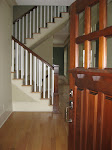In the search for energy savings and reduction of green house gases and global warming, this is a fact often overlooked -- that we get the biggest bang for the buck improving the energy efficiency of older structures, not the newest ones. Read this interesting article below. -- Pat
Home Remodels, Retrofits Key to Energy Efficiency in Housing
As the nation's home builders embrace green building in growing numbers, industry research indicates that even the most aggressive efficiency goals for new homes won't make a dent in overall energy consumption.
Instead, remodeling and retrofitting the nation's older homes is by far the more efficient solution, industry experts said at a Jan. 21 press conference at the International Builders' Show (IBS) in Las Vegas.
The panelists spoke as NAHB commemorated Green Day, drawing attention to the green education and certification programs offered by the association and the many green products, supplies and materials on display at IBS, the world's largest home building industry show.
The home building industry can combat the potential effects of global climate change by providing additional training to its members and by encouraging home owners to alter some of their habits and make energy-efficient improvements to their homes, the panelists said.
Federal energy officials estimate that Americans consume about 21% of the energy produced each year to operate and maintain their homes — for heating, cooling and electrical appliances, from stoves and refrigerators to televisions, computers and hair dryers. "By just making thoughtful choices, we can reduce that impact," said Ray Tonjes, chair of the NAHB Green Building Subcommittee and a green home builder in Austin, Texas.
"Energy efficiency is absolutely key to our nation's continued security and to our economy,” Tonjes said. “Additionally, we know that building with energy conservation in mind is practical and profitable. My industry has stepped up to the plate to prevent the effects of global warming — but we call it responding to market demand," he said.
The greatest energy savings can be achieved by making changes to existing housing, which is less energy-efficient than today's new homes, Tonjes said. "We obviously can't solve the problem by tearing down all our inefficient housing stock and replacing it with new. We need to make some significant improvements to our existing homes," he said.
Referring to the results of a study his company conducted for the California Homebuilding Foundation last fall, Mike Hodgson, president of the California energy consulting company ConSol Energy, said that 70% of the greenhouse gas emissions related to single-family envelope energy consumption can be attributed to homes built before 1983.
Further, the study demonstrated that spending $10,000 retrofitting a 1960s home could save 8.5 tons of carbon, at a cost of $588 to $1,176 per ton depending on tax credits and incentives. On the other hand, increasing the energy efficiency of a new home by 35% over current state requirements would cost about $5,000 and would reduce emissions by 1.1 tons at a cost of $4,545 per ton.
"Simple arithmetic demonstrates how retrofitting existing homes with energy-efficient features is four to eight times more carbon- and cost-efficient than adding further energy-efficiency requirements to new housing," Hodgson said.
Remodeler Devon Hartman of HartmanBaldwin, a Claremont, Calif design/build firm, said his customers are heeding the call. By adding insulation and sealing and tightening the duct system in one recent large home renovation project, Hartman was able to replace four older heating and air conditioning units totaling 16 tons with a new six-ton system. "We're no longer talking about just putting on sweaters or lowering the thermostat. We're talking about creating energy through efficiency measures," he said.
As more people turn to retrofitting and remodeling, demand will increase for so-called green jobs in which skilled employees either manufacture or install components in the energy-efficient homes of the future.
Fred Humphreys, president and CEO of the Home Builders Institute, the workforce development arm of NAHB, discussed new initiatives to prepare and train these workers, including major revisions of popular industry textbooks and other training materials to reflect today's improved knowledge of building science and green technology.
For more information, e-mail Calli Schmidt at NAHB, or call her at 800-368-5242 x8132.
Tuesday, February 3, 2009
Subscribe to:
Post Comments (Atom)






1 comment:
Post a Comment